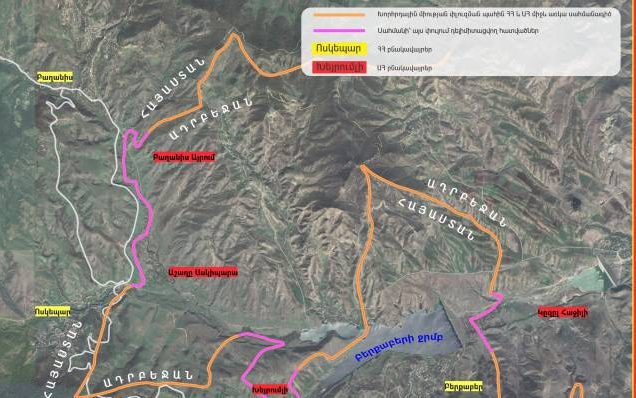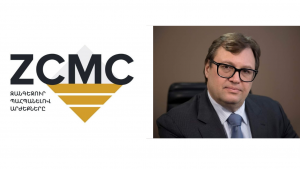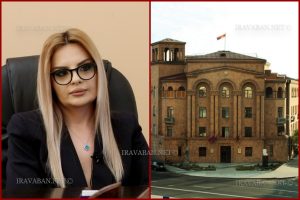The Information and Public Relations Department of the Prime Minister’s Office has responded “Armenpress” questions regarding the statement made by the commissions of Armenia and Azerbaijan on border delimitation issues on May 15.
The questions and answers are presented below:
Question: The border delimitation commissions of Armenia and Azerbaijan have issued a joint statement, which states that the Protocol-description of the borderline sections immediately between the settlements of Baghanis (Republic of Armenia) – Baghanis Ayrum (Republic of Azerbaijan), Voskepar (Republic of Armenia) – Ashaghi Askipara (Republic of Azerbaijan), Kirants (Republic of Armenia) – Kheyrimli (Republic of Azerbaijan) and Berkaber (Republic of Armenia) – Ghizilhajili (Republic of Azerbaijan) has been agreed on the basis of he 1976 topographic map of the General Staff of the USSR Armed Forces. What does it mean?
Answer – You are already aware that border markers have been installed by the respective working groups in the mentioned areas to locate the pre-agreed coordinates. Those coordinates are taken from the 1976 maps mentioned above. Now, cartographers have already agreed upon the border crossing lines between these markers, again based on the same maps. In other words, the reproduction of the borderline in these sections has been completed, agreed upon, signed, and the border is considered delimited in these areas.
Question – Why have maps from 1976 been chosen, which, as stated in the press release of the delimitation commissions, were used by the General Staff of the Armed Forces of the USSR?
Answer: In fact, it is a map that had a de jure legal basis at the time of the USSR’s dissolution. It was important for the government of the Republic of Armenia to adhere to the principle according to which a new border is not created between Armenia and Azerbaijan; rather, the existing de jure border at the time of the USSR’s dissolution is reproduced.
Question: The press release issued by the border delimitation commissions states that these maps went through the duty procedure in 1979.What does this mean, and why haven’t maps from, for example, 1990 been chosen?
Answer: This formulation is legal terminology, which means that in 1979, the authorized body in the field of cartography and geodesy of the USSR verified the accuracy and legal basis of the map. These maps were used until the dissolution of the Soviet Union. That is, these are the latest maps verified by competent state bodies of the USSR.
Question: Not all border markers have been installed in the village of Kirants in the Tavush region. How will this issue be resolved? In general, how are issues being resolved in the Kirants area? Will there arise a problem about building a new road or expropriating houses?
Answer: Three coordinates in the Kirants area have been determined using a computer; the markers will be installed later. The other markers have been installed. Good news for Kirants is that the village will regain about 25 hectares of agricultural land that has been inaccessible to Kirants for the past 33 years. The border description is exactly as presented on the 1976 map.
As mentioned earlier, the issue of road relocation will arise, but it can be addressed within 2-3 months. Additionally, the road leading from highway H-26 to Acharkut and further to Kirants, which serves as an alternative for Kirants, will be repaired. Regarding property matters, their scope will not be large, and any damage suffered by citizens in such cases will be compensated by the state through property or financial means according to their preference. Government representatives will commence inventorying potential issues and engaging in discussions with Kirants residents early in the morning.
Question: How do you evaluate the results of the delimitation in the areas of Baghanis, Voskepar, and Berkaber?
Answer: One of the most sensitive issues in the Voskepar-Baghanis area was related to the Church of the Holy Mother of God in the village of Voskepar, and the other was related to the Voskepar-Baghanis road, which has existed since the time of the USSR. Both issues have been resolved in the best possible way. The road remains entirely within the territory of the Republic of Armenia, as is the church, while the borderline is quite far from both the road and the church. There was and is no sensitive situation in Berkaber.
Question: When will border guards from the both sides be stationed along the agreed border?
Answer: This will happen within the next 8-9 days. In the most sensitive part of Kirants – a little later because some details there require additional clarification.
Question: There is an opinion that the current border delimitation process is a unilateral concession from the Republic of Armenia, and the security threats to the villages of Baghanis, Voskepar, Kirants, and Berkaber will become more acute.
Answer: Having a delimited border cannot pose a threat to the security of the country or any settlement. On the contrary, such a borderline neutralizes the threat. As for the concession, reproducing the border based on the Alma-Ata declaration cannot be considered a concession because we are reproducing our internationally recognized border line. The process should continue with the same logic and principles in other parts of the border as well.















